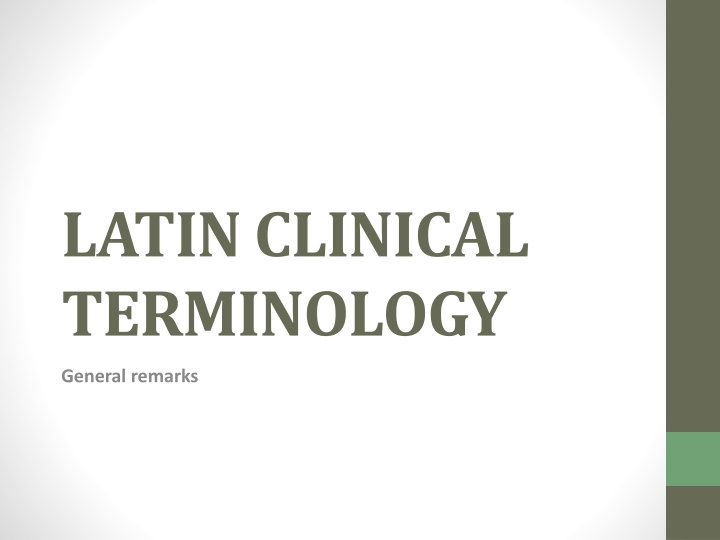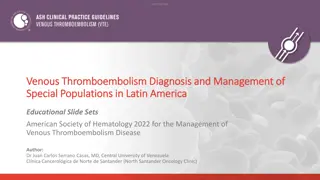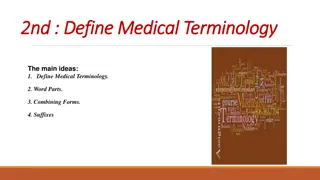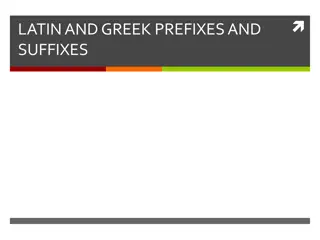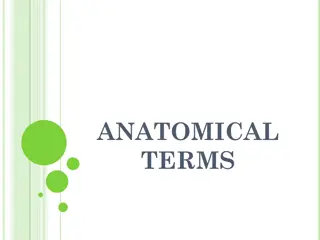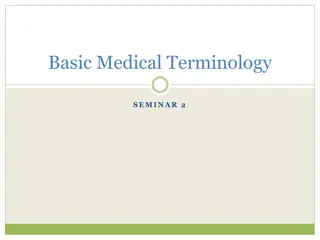Latin Clinical Terminology Overview
Clinical terminology encompasses a vast array of medical terms related to diseases, symptoms, treatments, and more. Its roots trace back to Greek and Latin origins, shaping the language of modern medicine. This historical foundation continues to influence the development and understanding of clinical terminology.
Download Presentation

Please find below an Image/Link to download the presentation.
The content on the website is provided AS IS for your information and personal use only. It may not be sold, licensed, or shared on other websites without obtaining consent from the author.If you encounter any issues during the download, it is possible that the publisher has removed the file from their server.
You are allowed to download the files provided on this website for personal or commercial use, subject to the condition that they are used lawfully. All files are the property of their respective owners.
The content on the website is provided AS IS for your information and personal use only. It may not be sold, licensed, or shared on other websites without obtaining consent from the author.
E N D
Presentation Transcript
LATIN CLINICAL TERMINOLOGY General remarks
Clinical terminology is a terminological complex of medico- biological branches including problems related to a sick organism. the clinic of the disease, i.e. its symptoms and manifestations, the disturbances of physiological functions, the structural alterations of the organs and tissues, treatment, prophylaxis. These names signify the huge amount of: different diseases pathological conditions and abnormalities medical examinations operations. This terminology also includes a great amount of paramedical vocabulary.
About 50 % English medical terms is of Greek origin The word clinical itself is of Greek origin (klinike means bed) Outstanding role of Greek physicians in both theoretical and practical medicine. Thanks to Greek physicians many diseases got their names and via Latin became part of European medical languages.
The Greeks were the founders of rational medicine in the golden age of Greek civilization in the 5th century B.C. The Hippocratic School and, later on, Galen (the Greek from Asia Minor who lived in Rome in the 2nd century A.D.) formulated the theories which dominated medicine up to the beginning of the 18th Century. The Hippocratics were the first to describe diseases based on observation, and the names given by them to many conditions are still used today, for example, arthritis, nephritis, pleuritis (pleurisy). The Greek language lends itself easily to the building of compounds. When new terms were needed, Greek words or Latin words with Greek endings were used (it is impossible to distinguish the two by their forms: appendicitis, creatinine, cystoscope, epinephrine, streptococcus). The fact is that about onehalf of our medical terminology is less than a century old. The third reason for using the classical roots is that they form an international language, easily understood by anyone familiar with the subject matter.
New clinical names coming into use were built, as a rule, on the base of Greek vocabulary and Greek morphological elements. The grammar form corresponds to the norms of Latin or other European languages. This historical tradition, in particular, is strictly followed in English. For example: of new clinical terms Latin aden tis cardiopathia oste ma English adenitis cardiopathy osteoma Meaning inflammation of a gland disease of the heart tumour of bone tissue Clinical terms composed on the base of Greek morphological elements have a very important advantage: they are short, but may stand in for a large clinical definition.
Themorphological structureofone- wordclinicalterms
Prefix Prefix. A prefix is a short word part added before a word or word root to modify its meaning. prefix uni- one unilateral affecting or involving one side prefix contra- against or opposite contralateral lateral side which refers to an opposite side prefix equi- equal equilateral having equal sides
Prefixes can denote or indicate position, location (upper, lower, in front of etc.) (abscessus retroperitonealis); direction of an action (forwards, backwards, through) (transfusio) time, period of time posttraumatica); quantity, number (a lot of, few) (polyarthritis); degree of quality, status (hyperfunctio ); absence or negation of mentioned in the stem (impotentia). (before, after) (arthritis
Word root/ combiningform/ root terminologicalelement Word root / combining form / root terminological element: is that part which contains the essential meaning of the word, any prefix or suffix added to the root will only function to add to the specificity of that word. Usually indicates a body part, such as cardi/o for heart gastr/o for stomach, neur/o for nerve. Medical terms always consist of at least one root, although they may contain more.
Initial root elements are combined in a one- word term with the final roots via the connecting vowel -o- or with the final suffixes. Final root elements are the most frequently used. Using one final TE one can create a lot of terms of the same type, by the same model: myalgia arthralgia podalgia neuralgia odontalgia
Finalrootelements Final root elements can be part of an adjective too, e. g.: -g nus, a, um in the term biog nus, a, um biogenic (caused by a vital organism). Some roots may be both initial and final odont- -odontia odontol thus, i m orthodontia, ae f odontolith, calculus on the teeth orthodontics, the part of dental surgery which is concerned with the prevention and correction of the malocclusion of teeth
Suffix/ finalterminologicalelement Suffix / final terminological element: Appears at the end of a medical term. Usually indicates a condition, procedure, disorder, or disease.
One-wordclinicalterms One should also remember that the final root or suffixed word building element is the first in the making up the literal translation of the term: nephrographia, ae f my ma, tis n the final root - graphia (X-ray examination) the initial root nephr- (kidney) the initial root my- (muscle) the final root - oma (tumour) the literal translation is X-ray examination of the kidneys , nephrography the literal translation is tumour of muscular tissue, myoma
One-wordclinicalterms 1) simple, containing only one stem; 2) compound, consisting of two or more morphological elements.
One-wordclinicalterms: 1) SIMPLE, CONTAINING ONLY ONE STEM 1.1. A ROOT AND AN ENDING. asthma, tis n asthma cancer, cri m cancer herpes, tis m herpes ulcus, ris n ulcer. These noun-terms are mostly used in combination with adjectives or nouns: asthma bronchiale bronchial asthma; ulcus gastris ulcer of the stomach.
One-wordclinicalterms: 1) SIMPLE, CONTAINING ONLY ONE STEM 1.2. A ROOT AND A SUFFIX (suffixed ending): chondr ma, tis n chondroma (tumour of cartilaginous tissue): a) the root chondr- cartilage ; b) the suffix - ma tumour . carcinoma, atis n cancer, malignant tumour morbilli, orum m measles rubeola, ae f rubella, german measles, epidemic roseola gastritis, itidis f gastritis
One-wordclinicalterms: 1) SIMPLE, CONTAINING ONLY ONE STEM 1.3. A PREFIX AND A ROOT: Hyperfunctio, onis f Dysfunctio, onis f
One-wordclinicalterms: 1) SIMPLE, CONTAINING ONLY ONE STEM 1.4. A PREFIX, A ROOT, A SUFFIX AND AN ENDING parametr tis, dis f parametritis (tissue inflammation near uterus). a) the prefix para- near ; b) the root metr- uterus ; c) the suffix - tis (combination of suffix -it- and ending -is) inflammation atrichia, ae f atrichia (lack of hair) a) the prefix a- absence, lack, cessation of a function ; b) the root trich- hair ; c) the ending ia endometritis, idis f intrauterine inflammation a) the prefix endo inside ; b) the root metr - uterus ; c) the suffix - tis (combination of suffix -it- and ending -is) inflammation
One-wordclinicalterms: 2) COMPOUND, CONSISTING OF TWO OR MORE ROOTS If there are two or more stems, the word is called compound. Composition is the most productive way of forming terms of Greek-Latin origin. Many components of compound terms are not used in modern terminology separately. They are used only as terminological elements in the derived words: -kardia (tachycardia). There are also TE which can be used as independent words. They are called free terminological elements: sclerosis cardiosclerosis stasis haemostasis
Linking/Combining/ Connective Vowelsorinterfix The two or several stems may be combined in one word with the help of connective vowel or interfix, which serve to make a term easier to pronounce. The most frequent interfix in the medical terminology is -o, more rarely -i. The first components of composition are indicated in the dictionaries with the interfix: thorac/o, spondylo-. Combining vowels are often used between roots and suffixes or roots and other roots, but they are NOT used between prefixes and roots.
Linking/Combining/ Connective Vowelsorinterfix hypermetropia, ae f hypermetropia (long-sightedness): a)the prefix hyper- (excess function); b)the root -metr- (dimension); c)the final root -opia (sight). rhinopathia, ae f rhinopathy (disease of the nose) : a)the root rhin- (nose); b)the connecting vowel -o-; c)the root pathia (disease); otorhinolaryngol gus, i m otorhinolaryngologist (the doctor for treating ear, nose and larynx diseases): a)the root ot- (ear); b)the root rhin- (nose); c)the root laryng- (larynx); d)the final root -logus (specialist in a medical region).
Linking/Combining/ Connective Vowelsorinterfix There are connections without interfix, they are met in terms the first component of which ends in the vowel or the second one begins with the vowel: brady (Gr. bradys slow) brachy (Gr. brachys short) Notice that there are vowels between the three roots. pelvimetria, ae f pelvimetry ( measuring of pelvis dimension in women); tachycardia, ae f tachycardia (abnormally fast heart rate). haemat + uria haematuria, ae f hematuria (blood in the urine); odont + algia odontalgia, ae f odontalgia (toothache, feeling of pain in the tooth). brady-cardia brachy-dactylia.
Linking/Combining/ Connective Vowelsorinterfix NB!!! Some exceptions to this rule are nevertheless found: the roots broncho- and bronchi- never lose their final vowels: bronchiectasia, ae f (= bronchoectasia) bronchiectasis (expansion of the bronchi); bronchoadenitis, it dis f bronchoadenitis (inflammation of lymphatic glands). The root bi- is always used with the connecting -o-: biocycle, biology, microbiology, biopharmaceutics.
YOU CAN UNDERSTAND THE MEANING OF A TERM IF YOU KNOW THE MEANINGS OF ALL COMBINING FORMS INCLUDED IN THIS TERM PREFIX, ROOT, SUFFIX. When you look at a medical term and attempt to decipher its meaning you begin with the suffix, move to the prefix (if present) and then the root word: pericarditis: 1) identify itis (meaning inflammation) 2) then peri (meaning around) 3) and then card (meaning heart). Therefore, this word means inflammation around the heart. Leukocytopenia: 1) penia (meaning decrease), 2) then leuk/o (meaning white) 3) and finally cyt/o (meaning cell). Therefore, this word means a decrease in white cells. TO UNDERSTAND THE MEANING OF THE TERM IT S NOT ENOUGH TO SUM UP THE MEANINGS OF ALL THE COMPONENTS.
BASIC RULES 1. A WORD ROOT PROVIDES THE BASIC MEANING OF THE TERM. Hepat- means liver in the term hepatitis (inflammation of the liver) 2. A PREFIX APPEARS BEFORE THE WORD ROOT TO CHANGE THE MEANING. Adding of prefix hypo- to the term dermic changes the meaning from pertaining to the skin to pertaining to below the skin 3. A SUFFIX APPEARS AT THE END OF THE WORD. In the term hepatitis suffix -itis which means inflammation is added to the root hepat-.
BASIC RULES 4. A COMBINING VOWEL CONNECTS WORD ROOTS. Laryngoscope o connects two roots: laryng- and -scope in the word meaning instrument for visual examination of the larynx (voice box) 5. A COMBINING FORM CONSISTS OF A WORD ROOT AND A COMBINING VOWEL. hepat + o = hepato (a combining form meaning liver) 6. A COMBINING VOWEL IS NOT USED BEFORE SUFFIXES AND ROOTS BEGINNING WITH A VOWEL, BUT IS USED BETWEEN TWO ROOTS IN A COMPOUND WORD. 7. THE MEANING OF A MEDICAL TERM CAN BE DETERMINED BY STARTING WITH THE SUFFIX AND MOVING BACK TO THE BEGINNING OF THE WORD; hepatitis means inflammation (-itis) of the liver (hepat-)
Variabilityoftheproducing stem Initial roots can have two or more variants: ger-, geront- (old men or old age); haem-, haemat- (blood). The base of Gen. Case is a producing stem of the Latin words: cortic-o-visceralis pan-, pant pan-demia, pant-o-phobia.
Word stressinginclinicalnames In the compound nouns with the ending -ia the last but one vowel i is, as a rule, stressed contrary to the rule vowel before vowel is short : atrichia bronchiectasia haematuria hypermetropia odontalgia rhinopathia The noun anat mia (anatomy) and nouns with the final element -logia keep the third syllable from the end stressed: cardiologia (cardiology) stomatologia (stomatology).
Multiwordclinical terms
Multiwordclinicalterms denote different deseases, pathological states and operative methods of treatment; consist of two, three and more words; are formed by nouns and adjectives in Nominativus and Genetivus Singularis or Pluralis; as a rule they are Latin; The noun containing the cardinal information of the term is placed first, and then one or two nouns or one or two adjectives follow; the second and third nouns indicate the localization of the diseased organ or tissue; adjectives give qualitative and quantitative characteristics of the morbid condition.
Structure of multiword clinical terms 1) noun in the Nom. case + noun in the Gen. case: fract ra costae cancer ventriculi tumor caeci infarctus cer bri
Structure of multiword clinical terms 2) noun in the Nom. case + adjective (you should remember about agreement of adjective with a noun in gender, case and number): tumor benignus stomat tis aphth sa chron ca tumor malignus myelopathia spondylogena asthma bronchiale typhus abdominalis
Structure of multiword clinical terms 3) noun in the Nom. case + noun in the Gen. case + adjective in Nom. (Gen.) fract ra membri inferi ris fract ra cr ris obl qua fractura colli femoris vulnus brachii laceratum sclerosis endocardii diffusa oedemata membrorum inferiorum
PECULIARITIES OF USAGE AND TRANSLATION OF PREFIXED TERMS 1. Latin prefixes are usually added to a Latin root, and Greek prefixes are added to a Greek root: hypoglossus, a, um sublingualis, e hemiplegia, ae f semicanalis, e NB!!! There are exceptions (hybrids): retropharyngeus, a , um (Latin prefix Greek root); epiduralis, e (Greek prefix Latin root)
PECULIARITIES OF USAGE AND TRANSLATION OF PREFIXED TERMS 2. In clinical terminology Greek prefixes are used mostly with the nouns, Latin with the adjectives. 3. Prefixes may have synonyms (with the same meaning) and antonyms (with contrasting meaning). Anti- and contra- mean against. Dys- and mal- mean bad or painful. Hyper-, supra-, and epi- all mean above. Hypo-, sub-, and infra- all mean below. Intra- and endo- mean within.
1.1. Prefixes denoting location, position Example Prefix Meaning Latin English abductio, onis f abnormalis, e abduction abnormal ab- off, from, away from ad-, ac-, at-, as- ap-, an-, ar-, af- to, (motion) toward, near acceleratio, onis f acceleration anaphylacticus, a, um analysis, is f anteversio, onis f apoplexia, ae f apophysis, is f cataplasia, ae f catabolismus, i m circumocularis, e circumoralis, e combustio, onis f conjugatio, onis f contralateralis, e contraindicatio, onis f anaphylactic analysis anteversion apoplexy apophysis cataplasia catabolism circumocular circumoral combustion conjugation contralateral contraindication an(a)- up, again, backward ante- before upon, away from, off, separate down, completely, according to ap/o, aph- cata- circum- around, about common with, together, jointly co-, con-, com- ontr(a)- against, opposite
1.1. Prefixes denoting location, position from, down from, away, reduce, remove through, across, apart, between, over deformans, ntis depilatorius, a, um dialysis, is f diathermia, ae f dissectio, onis f disorientatio, onis f eclampsia, ae f ectopicus, a, um ectoderma, atis n ectocervix, icis f encephalon, i n enophthalmus, i m endocardium, i n endoscopia, ae f epigastricus, a, um epicranialis, e esogastritis, itidis f extractio, onis f exophthalmus, i m efferens, entis exocervix, icis f deforming depilatory dialysis diathermy dissection disorientation eclampsia ectopic ectoderm ectocervix encephalon enophthalmus endocardium endoscopia epigastric epicranial esogastritis extraction exophthalmus efferent exocervix de- dia- dis-, dif- to undo, free from, apart, away ec- outer, outside of, out, away ecto- outer, outside cover with, among, within; inner location within, inside; inner part of an organ on, upon, outside, at, to, in addition inward en-, em- end/o epi- eso- outward, from, beyond, away from, out of ex-, ef-, e- exo- outside, outward
1.1. Prefixes denoting location, position extracardialis, e extracellularis, e hypoplasia, ae f hypogastrium, i n hyperextensio, onis f incisio, onis f inversio, onis f infraorbitalis, e infraclavicularis, e intercostalis, e interosseus, a, um intraoralis, e intracranialis, e juxtapositio, onis f juxtaosseus, a, um mesencephalon, i n mesocolon, i n metamorphosis, is f metastasis, is f extracardial extracellular hypoplasia hypogastrium hyperextension incision inversion infraorbital infraclavicular intercostal interosseous intraoral intracranial juxtaposition juxtaosseous mesencephalon mesocolon metamorphosis metastasis extra- outside of, beyond hyp/o below, under hyper- above in, on, upon, into, toward; inner location in-, im-, ir-, il- infra- under, below, beneath inter- between, among, jointly intra- within, inside juxta- near, beside mes/o middle after, beyond, among, with, between, behind met(a)-, meth-
1.1. Prefixes denoting location, position beside, beyond, around, near parodontosis, is f paracystitis, itidis f perforatio, onis f percutaneus, a, um periodontitis, itidis f pericardium, i n postnasalis, e posthepaticus, a, um praemolaris, e prognathia, ae f retroperitoneus, a, um retropharyngeus, a, um sublingualis, e subcostalis, e supragingivalis, e suprarenalis, e syndromum, i n syndactylia, ae f transfusio, onis f transmissio, onis f parodontosis paracystitis perforation percutaneous periodontitis pericardium postnasal posthepatic premolar prognathia retroperitoneal retropharyngeal sublingual subcostal supragingival suprarenal syndrome syndactylia transfusion transmission par(a)- per- though, throughout tissues surrounding, near, enclosing an organ peri- post- after prae- (Eng. pre-) pro- in front of before, forwards retro- back, behind under, inferior to, beneath, below sub- supra- above, beyond together, joined, with, same through, across, beyond, over, outside syn-, sym-, syl- trans-
1.2. Prefixes modifying functions Example Prefix Meaning Latin English without; absence of function or property amnesia, ae f anaemia, ae f amnesia anemia a-, an- ant/i against antisepticus, a, um antiseptic lack of, reduce, negation, decreased, remove desinfectio, onis f decapitatio, onis f desinfection decapitation de-, des- difficult, painful, abnormal; functional disorders dysfunctio, onis f dysgeusia, ae f dysfunction dysgeusia dys- increased, more than normal, too much, high hypertensio, onis f hypertrophia, ae f hypertension hypertrophy hyper-
1.2. Prefixes modifying functions Example Prefix Meaning Latin English incomplete, decreased, less than normal hypoglycaemia, ae f hypothermia, ae f hypoglycemia hypothermia hyp/o in-, im-, ir-, il- inoperabilis, e immobilitas, atis f inoperable immobility not, without protection from, abnormal, variation, similarity paraesthesia, ae f paratyphus, i m paresthesia paratyphus par(a)- sub- below, decreased, inferior to subacutus, a, um subacute increased, more than normal, higher in quality supersecretio, onis f superficialis, e supersecretion superficial super- ultra- above, extreme, more than ultrafiltratio, onis f ultrafiltration
1.3. Prefixes denoting time Example Prefix Meaning Latin English back, against, again, throughout an(a)- anabiosis, is f anabiosis ante- before, earlier antenatalis, e antenatal peri- around, near perinatalis, e perinatal post- after postnatalis, e postnatal prae- (Eng. pre-) before, earlier praecancerosus, a, um precancerous pro- before prophylaxis, is f prophylaxis again, anew, backward, reproduction re- reinfectio, onis f reinfection
1.4. Prefixes denoting layers of the organs Meaning of suffix Prefix Root Suffix Meaning of term Examples endocardium, endometrium pericardium, perimetrium paranephritis, parametrium mesoarteritis, mesometrium pancarditis, panmetritis end/o inner layer of organ external layer of organ peri- -itis, itidis f, -ium, i n inflammation/ disease para- organ tissue near an organ mes/o mesentery pan- all the layers of organ
1.5. Prefixes with the opposite meaning Prefix Examples and their meaning Prefix Examples and their meaning - traumatic pertaining to injury a- without, no atraumatic without injury - uria urination an- without, no anuria absence of urine ab- away from abduction taking away from the midline ad- toward adduction moving towards the midline - emetic pertaining to vomiting anti- against antiemetic against vomiting dys- difficult, painful, bad dyspnea difficult breathing dysplasia abnormal development eu- good, easy, normal eupnea normal breathing euplasia normal, typical state endocrine to secrete internally ex/o outside exocrine to secrete externally (via a duct) end/o within, inside endoparasite an organism that lives within the body of host ectoparasite an organism that lives on the outer surface of host ecto- outside esotropia a type of strabismus (one eye turns inward) eso- inward exo- outside exotropia a type of strabismus
1.5. Prefixes with the opposite meaning Prefix Examples and their meaning Prefix Examples and their meaning hyper- more than normal hyperglycemia elevated amounts of blood glucose hyp/o less than normal hypoglycemia blood glucose depressed amounts of supra- above supraclavicular above the clavicle infra- below infraclavicular below the clavicle epi- upon epidural upon the dura mater sub- beneath subdural beneath the dura mater inter- between intercostal between the ribs intra- within intramuscular within the muscle prae- (Eng. pre-) before preanesthetic before anesthesia post- after postanesthetic after anesthesia super- above, excessive superacute extremely acute sub- under, less subacute moderately acute subclavicular beneath the clavicle supra- above, excessive suprascapular above the shoulder blade supraclavicular above the clavicle
1.6. Latin-Greek doublet prefixes Examples Greek prefix Latin prefix Meaning Latin English Latin English intra- end/o inside intrauterinus, a, um intrauterine endocardium, i n endocardium ecto-, exo- extra- outside extracardialis, e extracardial ectoderma, atis n ectoderm anteversio, onis f anteversion ante-, pro-, prae- (Eng. pre-) prognosis, is f prognathia, ae f prognosis prognathia pro- before praesenilis, e presenil met(a)-, meth- after, posterior post- postfebrilis, e postfebrile metencephalon, i n metencephalon infrascapularis, e subscapular under; insufficiency infra-, sub- hyp/o sublingualis, e sublingual hypogastrium, i n hypogastrium subacutus, a, um subacute
1.6. Latin-Greek doublet prefixes Examples Greek prefix Latin prefix Meaning Latin English Latin English infrascapularis, e subscapular under; insufficiency infra-, sub- hyp/o sublingualis, e sublingual hypogastrium, i n hypogastrium subacutus, a, um subacute supraclavicularis, e supraclavicular epicranialis, e epicranial supra- super- epi-, hyper- above, excessive supersecretio, onis f supersecretion hypertonia, ae f hypertony inter- mes/o between interosseus, a, um interosseous mesogastrium, i n mesogastrium against, opposite contra- anti- contralateralis, e contralateral antitoxinum, i n antitoxin in-, im-, il-, ir- a-, an- absence, negation inoperabilis, e inoperable atonia, ae f atony semi- hemi- half semicanalis, e half-canal hemiplegia, ae f paralysis con- syn- together conjugatio, onis f conjugation symbiosis, is f symbiosis
SUFFIXES USED IN MEDICAL TERMINOLOGY
2.1. THE NOUN SUFFIXES USED IN MEDICAL TERMINOLOGY Example Suffix Meaning Latin English relating to some action or the result of an action operatio, onis f operation - tio, nis f (Eng. -ation) enanthema, atis n erythema, atis n enanthema erythema - ma, tis n pathological condition action; pathological state process; pneumonia, ae f phobia, ae f pneumonia phobia -i-a, ae f non inflammatory disease helminthiasis, is f nephrolithiasis, is f pericardium, ii n helminthiasis nephrolithiasi s pericardium -i s-is, is f structure, tissue -i-um, ii n disease inflammatory poisoning; characteristic of non- gigantismus, i m mycetismus, i m gigantism mycetism -ism-us, i m (Eng. - ism) nature; system,
